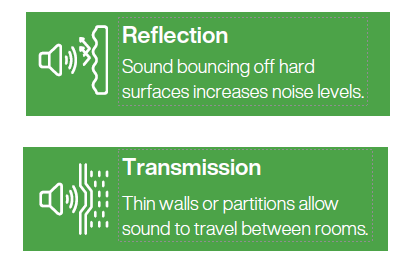The Future of Learning Spaces: Sound Management in Education
The way we design and manage learning spaces has a profound impact on education. Among the many factors shaping modern classrooms, speech privacy and acoustic quality stand out as key contributors to effective learning and teaching. In educational settings, noise disrupts focus, and private conversations require discretion. This blog examines speech privacy challenges in schools and colleges, highlighting acoustic solutions that enhance learning environments. At Lencore, we’ve seen through our clients how sound management transforms education. From sound masking systems to cutting-edge acoustic designs, we’re here to help you create better learning environments for students and educators alike.
Understanding Speech Privacy in Education
Speech privacy ensures conversations remain confidential while reducing background noise distractions. It is essential for clear communication, confidentiality, and productivity across various environments. In education, maintaining speech privacy is especially critical for several key reasons:
Student Focus
Noise distractions can significantly hinder a student’s ability to absorb information and stay engaged in their learning. Ensuring a quiet environment promotes better comprehension, memory retention, and overall academic success.
Confidentiality
Educational institutions often require private, comfortable spaces for sensitive conversations, such as counseling sessions, disciplinary meetings, and discussions with parents or guardians. Ensuring a secure and distraction-free environment fosters trust, enhances comfort, and ensures compliance with privacy regulations.
Productivity
When distracting noise levels are minimized, a quieter, more focused environment is created. This boosts student productivity, especially during independent work sessions since they can concentrate better and complete assignments more efficiently.
Modern classrooms, however, present unique challenges that make achieving speech privacy more difficult:
- Open Floor Plans: While open concept and mixed-use areas like libraries encourage collaboration, they also amplify sound, creating distractions and making it harder to maintain focus.
- Thin Walls and Partitions: Many schools prioritize cost-effective construction, which often results in poor sound insulation between classrooms or offices.
- External Noise Sources: Sounds from hallways, outdoor areas, or adjacent spaces can seep into learning environments, further disrupting the flow of lessons and activities.
Addressing these challenges requires innovative solutions that balance the need for collaborative spaces with the importance of acoustic control. By prioritizing sound management, institutions can create environments that not only support academic achievement but also foster well-being and effective communication for students, teachers, and administrators alike.
The Evolution of Learning Spaces
Educational spaces have undergone significant transformations over the years, evolving to meet the dynamic needs of modern teaching and learning. Traditional classrooms, characterized by enclosed spaces with individual desks and minimal technological integration, have gradually given way to open-concept designs, collaborative workspaces, and hybrid learning setups that blend in-person and virtual instruction.
These changes have been driven by a shift toward fostering creativity, interaction, and flexibility. While these trends have created environments that encourage collaboration and innovative thinking, they also introduce new challenges, particularly when it comes to maintaining acoustic balance and minimizing distractions.
Some of the key challenges include:
- Amplified Noise in Open Spaces: Open-concept schools and common areas are designed to encourage group activities and peer interaction. However, the absence of physical barriers can lead to increased noise levels that disrupt concentration for students and teachers alike.
- Multipurpose Spaces: Many modern educational facilities feature multipurpose rooms used for various activities, from lectures to group discussions. The lack of tailored acoustic solutions in these spaces can make it challenging to balance the needs of different uses.
- Design Aesthetics vs. Functionality: While sleek, modern designs prioritize visual appeal, they often overlook the importance of acoustic control, using surfaces that reflect and amplify noise rather than absorb it.
Addressing these challenges requires thoughtful planning and advanced acoustic solutions. By integrating sound masking systems, noise-absorbing materials, and smart audio technologies, schools can create environments that support both collaboration and focus, ensuring that the benefits of modern educational spaces are fully realized without compromising on speech privacy and sound quality.
Benefits of Speech Privacy in Education
Speech privacy plays a pivotal role in creating productive, supportive, and effective learning environments for everyone involved in education. From students to teachers to administrators, maintaining optimal acoustic conditions delivers significant benefits:
For Students 
Improved Focus and Comprehension
A quieter environment allows students to concentrate better, absorb information more effectively, and engage fully in classroom activities. This is particularly important for young learners and students with attention-related challenges, as distractions can have a disproportionate impact on their ability to succeed academically.
Reduced Stress and Anxiety
Excessive noise can create a sense of chaos and overwhelm, leading to stress and frustration among students. Acoustic solutions that minimize background noise help foster a calm and focused atmosphere, enhancing overall student well-being.
 For Teachers
For Teachers
Enhanced Teaching Effectiveness
With fewer noise interruptions, teachers can deliver lessons with greater clarity and efficiency. They spend less time managing classroom distractions and more time engaging with students and delivering quality instruction.
Confidentiality in Discussions
With fewer noise interruptions, teachers can deliver lessons with greater clarity and efficiency. They spend less time managing classroom distractions and more time engaging with students and delivering quality instruction.
 For Administrators
For Administrators
Compliance with Privacy Regulations
Educational institutions are often subject to legal requirements related to privacy, particularly in counseling sessions, special education services, and administrative matters. Speech privacy solutions help schools meet these obligations and maintain a professional standard.
Positive Feedback on the Learning Environment
Parents, teachers, and staff are more likely to view the school environment favorably when it supports productivity, focus, and communication. Acoustic enhancements contribute to creating a space where students thrive and educators feel empowered.
Effective sound management goes beyond just controlling noise—it plays a crucial role in creating an environment where students can focus, teachers can engage, and administrators can operate efficiently. By optimizing acoustics, schools can enhance learning outcomes, reduce stress, and cultivate a more supportive and productive atmosphere for everyone.
The Science Behind Speech Privacy and Sound Masking
To understand speech privacy, we need to explore how sound travels in learning spaces:

In environments where privacy and concentration are essential, excessive noise and intelligible speech can be major distractions. Sound masking offers an effective solution by introducing a low-level, unobtrusive background sound that reduces speech intelligibility, enhancing confidentiality and focus. Metrics like the Speech Intelligibility Index (SII) and Noise Reduction Coefficient (NRC) help evaluate the effectiveness of these acoustic solutions, ensuring optimal performance.
The Future of Acoustic Design in Education
The future of learning spaces is driven by technology and innovation:
- Smart Adaptive Acoustics: Schedule or manually adjust sound in real-time with System Manager for optimal comfort and focus.
- Smart Building Integration: Linking acoustic systems with HVAC, lighting, and security for a holistic approach.
- Sustainability: Eco-friendly materials and energy-efficient systems becoming standard.
Conclusion
Speech privacy isn’t just about reducing noise—it’s about creating an environment where students and teachers can thrive. With the right acoustic strategies, educational spaces can support focus, foster collaboration, and maintain confidentiality. At Lencore, we’re committed to designing solutions that meet the demands of modern learning environments. Let us help you transform your school into a space where sound works for you, not against you. Contact us today.
